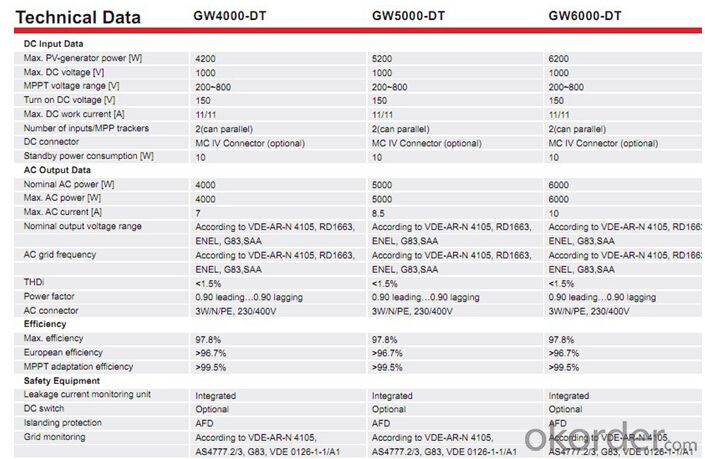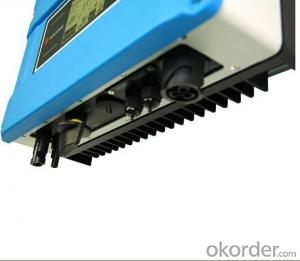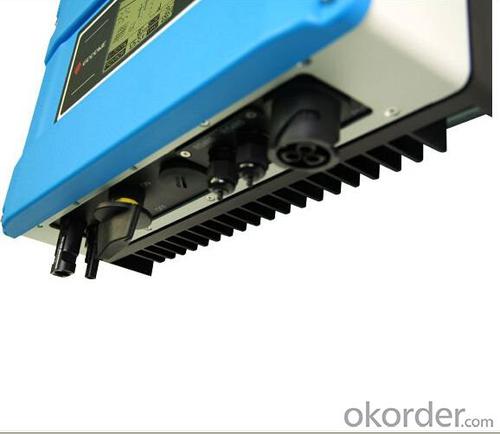MPP Solar Inverter GW6000-DT On Grid Solar Inverter
OKorder Service Pledge
Quality Product, Order Online Tracking, Timely Delivery
OKorder Financial Service
Credit Rating, Credit Services, Credit Purchasing
You Might Also Like
GW6000-DT inverters are typically designed for home solar systems,
4kW/5kW/6kW.By adopting cutting-edge technology of photovoltaic field,
it provides three making home system connection well balanced ,safer and more convenient.
The integrated allow two-array inputs from different roof orientations.
And the combination of both RS485 communication makes the system well interactive and extremely easy to be monitored.
Datasheet

- Q: Can a solar inverter be used with building-integrated photovoltaic systems?
- Yes, a solar inverter can be used with building-integrated photovoltaic systems. Building-integrated photovoltaic systems are designed to seamlessly integrate solar panels into the building's architecture, and a solar inverter is an essential component that converts the DC power generated by the solar panels into AC power for use in the building's electrical system.
- Q: Can a solar inverter be easily integrated into an existing electrical system?
- Yes, a solar inverter can be easily integrated into an existing electrical system. It can be connected to the main electrical panel to convert the DC power generated by solar panels into AC power that can be used to power appliances and devices in the building. However, it is important to consult with a professional electrician to ensure proper installation and compatibility with the existing system.
- Q: Can a solar inverter work without sunlight?
- No, a solar inverter cannot work without sunlight. It relies on the energy generated by solar panels, which convert sunlight into electricity. Without sunlight, there is no source of energy for the solar inverter to convert, rendering it inoperable.
- Q: Can a solar inverter be used in three-phase systems?
- Yes, a solar inverter can be used in three-phase systems. In fact, there are specific three-phase solar inverters designed to convert the DC power generated by solar panels into AC power for utilization in three-phase electrical systems. These inverters are capable of efficiently managing the power flow and ensuring balanced distribution across all three phases.
- Q: How does a solar inverter handle reverse power flow?
- A solar inverter handles reverse power flow by automatically detecting the excess power generated by the solar panels and diverting it to the utility grid. This process, known as anti-islanding, ensures a safe and efficient operation of the solar system by preventing overloading and potential damage to the inverter.
- Q: How does a solar inverter handle variations in solar panel tilt and orientation?
- A solar inverter handles variations in solar panel tilt and orientation by continuously monitoring the output voltage and current of the solar panels. It then adjusts the power conversion process to optimize the efficiency of power generation based on the tilt and orientation of the panels. This ensures that maximum power is extracted from the solar panels regardless of their position, allowing for optimal energy production.
- Q: What is the difference between a grid-tied and off-grid solar inverter?
- A grid-tied solar inverter is designed to convert the DC (direct current) electricity generated by solar panels into AC (alternating current) electricity that can be used in a home or business. It is connected to the utility grid, allowing surplus electricity to be sold back to the grid. In contrast, an off-grid solar inverter is specifically designed to be used in standalone systems where there is no access to the utility grid. It converts the DC electricity generated by solar panels into AC electricity for immediate use or storage in batteries for later use.
- Q: What are the common issues and troubleshooting steps for a solar inverter?
- Common issues with solar inverters can include issues with the inverter not turning on, no power output, low power output, intermittent power output, or error messages displayed on the inverter. Here are some troubleshooting steps to address these issues: 1. Check the power supply: Make sure that the inverter is properly connected to the power source and that there is no issue with the electrical supply. Check the circuit breaker or fuse box to ensure it has not tripped. 2. Inspect the wiring: Examine the wiring connections to ensure they are secure and not damaged. Loose or disconnected wires can cause power issues. If any damage is found, consider contacting a professional electrician to repair or replace them. 3. Clean solar panels: Dust, debris, or shading on solar panels can reduce the power output. Clean the panels using a soft cloth or a hose. If there is shading from nearby trees or structures, consider trimming or removing them if possible. 4. Check for error messages: If the inverter displays an error message, refer to the user manual or manufacturer's website for the meaning of the error code and recommended troubleshooting steps. If necessary, contact the manufacturer's customer support for further assistance. 5. Monitor the weather conditions: Solar inverters may have reduced power output during cloudy or overcast days. However, if the power output is consistently low even in optimal weather conditions, there may be an issue with the inverter itself. 6. Reset the inverter: Some inverters have a reset button or option. Try resetting the inverter to its factory settings, but keep in mind that doing so may erase any customized settings or configurations. 7. Firmware updates: Check if there are any available firmware updates for your specific inverter model. Updating the firmware can sometimes resolve issues and improve performance. 8. Consult a professional: If the troubleshooting steps above do not resolve the issue, it is recommended to contact a professional solar installer or electrician. They have the expertise and equipment to diagnose and repair more complex issues with solar inverters. Remember, safety should always be a priority when troubleshooting electrical equipment. If you are unsure or uncomfortable with any troubleshooting steps, it is best to seek professional assistance to avoid any potential hazards.
- Q: Can a solar inverter be used with a three-phase electrical system?
- Yes, a solar inverter can be used with a three-phase electrical system. In fact, many commercial and industrial solar installations use three-phase inverters to convert the direct current (DC) power generated by solar panels into alternating current (AC) power that can be used by the electrical grid. This allows for efficient power conversion and distribution in three-phase systems, which are commonly used in larger electrical installations.
- Q: How does a solar inverter provide ground fault protection?
- A solar inverter provides ground fault protection by continuously monitoring the current flow between the solar panels and the electrical grid. If any ground fault or leakage current is detected, the inverter immediately interrupts the circuit to prevent potential electrical shock hazards and damage to the system.
Send your message to us
MPP Solar Inverter GW6000-DT On Grid Solar Inverter
OKorder Service Pledge
Quality Product, Order Online Tracking, Timely Delivery
OKorder Financial Service
Credit Rating, Credit Services, Credit Purchasing
Similar products
Hot products
Hot Searches
Related keywords


























